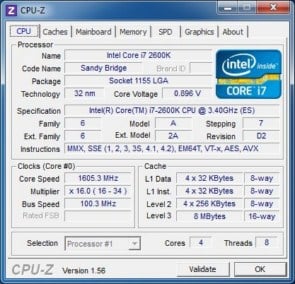Intel Core i7-2600K and i5-2500K Processors Debut
Below are a couple of screenshots from the latest version of CPU-Z that detail some of the new Core i5-2500K and Core i7-2600K processors’ inner-workings.
As you can see, and we’ve already mentioned, the chips utilize the new socket 1155 and are built using Intel’s 32nm process node. The chips we tested and that will hit retail shelves are revision D2, with stepping 7 and they feature a 100MHz BCLK. And other than their frequencies, support for HyperThreading and L3 / LLC cache sizes, the Core i5-2500K and Core i7-2600K are essentially identical. There has been a lot of scuttlebutt regarding Sandy Bridge and its potentially limited overclocking. The reason for all the chatter is because Sandy Bridge based processors have an on-die clock generator and much more complex design that cannot handle high BCLK frequencies in its current form. So, what Intel has done in an attempt to satisfy the overclocking market is introduce K-series SKUs that are totally unlocked for easy overclocking via multiplier manipulation. But take note that other non-K SKUs will also have “limited” unlocking which will allow for multipliers to be increased by up to 4 speed bins above the processor’s peak, official Turbo frequency. Now, while there’s not nearly as much BCLK headroom as previous architectures, that doesn’t mean it can’t be altered at all. The BCLK on current Sandy Bridge chips can typically be increased by up to 5%-9% or so. With a default BCLK of 100MHz, that means about 105MHz to 109MHz (give or take a few MHz) will typically be possible, depending on the particular chip. We spent some time tweaking our Core i7-2600K using the stock Intel high-performance cooler and an Asus P8P67 Deluxe motherboard and were easily able to hit a rock-solid and perfectly stable peak frequency of 4.57GHz. We achieved this speed by increasing the CPU voltage to 1.35v, with a multiplier of 44 and a BCLK of 104MHz. With more tweaking, we're certain higher clocks will be possible. We were actually told by Asus that approximately 50% of Sandy Bridge CPUs can hit 4.4-4.5GHz, 40% can hit up to 4.6-4.7GHz, and about 10% will reach up to 4.8-5GHz. We should also mentioned that at the speeds we hit, with the stock cooler, temperatures were absolutely not an issue. While overclocked, the 2600K idled in the high 40'C range and peaked in the low 70'C range.

Core i5-2500K CPU Details

Core i5-2500K Cache Details

Core i7-2600K CPU Details
Core i7-2600K Cache Details
The Core i5-2500K has 6MB of L3, whereas the i7-2600K has 8MB. There is 64K (32K data, 32K instruction) of L1 cache per core, and 256K of L2 cache per core. All of the caches are 8-way set associative, with the exception of the L3 / LLC which is 12-way set associative on the Core i5-2500K and 16-way on the i7-2600K.
The highest multiplier available on K SKUs is 57, which would equate to 5.7GHz, but it’s not likely that kind of frequency will be possible. These processors are highly overclockable, though.
Intel Core i7-2600K Overclocked to 4.57GHz






